+Search query
-Structure paper
| Title | Dynamics in a pure encounter complex of two proteins studied by solution scattering and paramagnetic NMR spectroscopy. |
|---|---|
| Journal, issue, pages | J Am Chem Soc, Vol. 130, Issue 20, Page 6395-6403, Year 2008 |
| Publish date | May 21, 2008 |
 Authors Authors | Xingfu Xu / Wolfgang Reinle / Frank Hannemann / Peter V Konarev / Dmitri I Svergun / Rita Bernhardt / Marcellus Ubbink /  |
| PubMed Abstract | In the general view of protein-complex formation, a transient and dynamic encounter complex proceeds to form a more stable, well-defined, and active form. In weak protein complexes, however, the ...In the general view of protein-complex formation, a transient and dynamic encounter complex proceeds to form a more stable, well-defined, and active form. In weak protein complexes, however, the encounter state can represent a significant population of the complex. The redox proteins adrenodoxin (Adx) and cytochrome c (C c) associate to form such a weak and short-lived complex, which is nevertheless active in electron transfer. To study the conformational freedom within the protein complex, the native complex has been compared to a cross-linked counterpart by using solution scattering and NMR spectroscopy. Oligomerization behavior of the native complex in solution revealed by small-angle X-ray scattering indicates a stochastic nature of complex formation. For the cross-linked complex, interprotein paramagnetic effects are observed, whereas for the native complex, extensive averaging occurs, consistent with multiple orientations of the proteins within the complex. Simulations show that C c samples about half of the surface area of adrenodoxin. It is concluded that the complex of Adx/C c is entirely dynamic and can be considered as a pure encounter complex. |
 External links External links |  J Am Chem Soc / J Am Chem Soc /  PubMed:18439013 PubMed:18439013 |
| Methods | SAS (X-ray synchrotron) / NMR (solution) |
| Structure data | 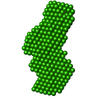 SASDAN5: 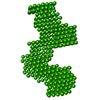 SASDAP5: 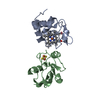 PDB-2jqr: |
| Chemicals | 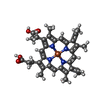 ChemComp-HEC: 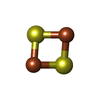 ChemComp-FES: |
| Source |
|
 Keywords Keywords | ELECTRON TRANSPORT / Cytochrome c / Adrenodoxin / Crosslinked complex / 2Fe2S Ferredoxin / Pseudocontact shift / Paramagnetic relaxation enhancement / encounter complex |
 Movie
Movie Controller
Controller Structure viewers
Structure viewers About Yorodumi Papers
About Yorodumi Papers






